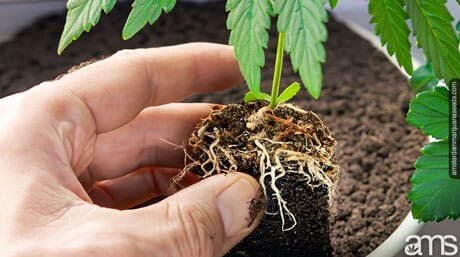marijuana growing
Open Soil vs. Plant Pots
Published
11 months agoon
By
admin
Introduction:
Cannabis cultivation has gained considerable attention in recent years, thanks to its increasing legalization and therapeutic potential. While many growers focus on lighting, nutrients, and watering techniques, the significance of the root system is often overlooked. The root system plays a crucial role in supporting the plant’s overall health, growth, and nutrient absorption. In this article, we will explore the root system of the cannabis plant and delve into the differences between growing in open soil versus using various types of plant pots, such as large pots, small pots, round pots, square pots, and even felt pots.
Understanding the Cannabis Root System:
The root system of the cannabis plant is a complex and intricate network that plays a fundamental role in its growth and overall well-being. A deeper understanding of the root system can help growers optimize cultivation practices and achieve healthier and more productive plants.
The taproot system of cannabis consists of a central main root known as the taproot, which grows vertically downward into the soil. From the taproot, numerous lateral roots branch out horizontally, extending and exploring the surrounding soil. These lateral roots form a dense fibrous network, which is responsible for water and nutrient absorption.
One key advantage of the taproot system is its ability to reach deeper into the soil profile, accessing nutrients and moisture sources that may not be readily available to plants with shallower root systems. The taproot acts as an anchor, providing stability to the plant and allowing it to withstand environmental stressors such as wind and heavy rainfall.
Open Soil Cultivation:
Growing cannabis directly in open soil offers several advantages for the development of a robust root system. In open soil, cannabis plants have the freedom to spread their roots as far as they need to, enabling the establishment of a strong foundation and maximizing nutrient absorption.
One of the primary benefits of open soil cultivation is the ability of the roots to explore a larger volume of soil. This exploration leads to increased access to essential nutrients and water sources, resulting in improved overall plant health. The plants can tap into deeper layers of soil, where vital nutrients may be more abundant.
Furthermore, open soil provides excellent drainage properties, allowing excess water to escape easily. Proper drainage prevents waterlogging, which can suffocate the roots and lead to root rot. The presence of oxygen in the soil is crucial for root respiration, and open soil allows for better aeration, promoting healthy root development.
In open soil, beneficial soil microbes and organisms play a vital role in the breakdown of organic matter, releasing nutrients in a form that plants can readily absorb. These microbes contribute to the creation of a healthy soil ecosystem, fostering symbiotic relationships with the roots and enhancing nutrient availability.
Additionally, open soil cultivation allows for a more natural expression of the cannabis plant’s genetic potential. The unrestricted growth of roots provides the plant with the space it needs to develop to its fullest. This can result in potentially higher yields and improved terpene profiles, as the plant is able to fully express its genetic traits without the constraints of container cultivation.
It is important to note that open soil cultivation requires careful consideration of the soil composition and preparation. Proper soil testing and amendment can ensure that the necessary nutrients are available in the soil to support healthy root development. Organic matter, such as compost or well-rotted manure, can be incorporated into the soil to enhance its fertility and structure.
Overall, open soil cultivation offers numerous benefits for cannabis plants, particularly when it comes to root system development. The ability of the roots to explore a larger volume of soil, access deeper nutrient sources, and interact with beneficial soil organisms contributes to overall plant health and productivity. By providing an optimal growing environment through open soil cultivation, growers can lay the foundation for thriving cannabis plants.
Plant Pot Cultivation:
While open soil cultivation offers several advantages, growing cannabis in plant pots has gained popularity due to its versatility and ease of management. Let’s explore the differences between large pots, small pots, round pots, square pots, and even felt pots:
- Large Pots: Large pots provide ample space for the roots to spread, allowing for better nutrient absorption and overall plant health. The increased soil volume helps maintain stability and reduces the risk of nutrient deficiencies or waterlogging. It is particularly beneficial for larger cannabis varieties with extensive root systems. The larger size of these pots also offers more room for organic matter, such as compost or beneficial microbes, which can enhance soil fertility and promote healthy root development. Furthermore, large pots provide a buffer against rapid changes in environmental conditions, such as temperature fluctuations, ensuring a more stable growing environment for cannabis plants.
- Small Pots: Small pots are suitable for limited growing spaces and indoor cultivation. However, they restrict root expansion and may necessitate more frequent watering and nutrient supplementation. The limited soil volume can lead to stunted growth and hinder the plant’s ability to reach its full potential. To overcome these limitations, growers using small pots can employ techniques like frequent fertigation (the combination of fertilization and irrigation) to ensure the plants receive adequate nutrients. Additionally, optimizing the soil composition by adding organic matter and using well-draining substrates can improve moisture retention and nutrient availability in small pots. Careful attention to plant care and monitoring is crucial in maximizing the performance of cannabis plants in small pots.
- Round Pots: Round pots allow for even root distribution and encourage a more natural root growth pattern. The absence of corners eliminates the possibility of root binding, ensuring the plant can access nutrients and water evenly. The circular shape of round pots promotes a balanced distribution of lateral roots, preventing overcrowding and enhancing nutrient uptake efficiency. Additionally, round pots facilitate better airflow around the root zone, reducing the risk of excess moisture and root diseases. The uniform distribution of roots in round pots also contributes to better stability and minimizes the risk of toppling, especially when plants become top-heavy during the flowering stage.
- Square Pots: Square pots are preferred by some growers as they make efficient use of space, allowing for easy organization and maximizing the number of plants per square meter. However, they can promote root circling if not managed properly. When the roots reach the corners of square pots, they may begin to circle around the container, potentially affecting nutrient uptake and overall plant health. To mitigate this issue, growers should regularly inspect the root system and transplant the plants to larger containers when necessary. Additionally, employing techniques like root pruning by trimming the circling roots before transplanting can encourage a more outward growth pattern and prevent root-binding issues. By maintaining proper root management, square pots can be an effective option for optimizing space utilization in cannabis cultivation.
- Felt Pots: Felt pots, also known as fabric pots or smart pots, have gained popularity among cannabis cultivators. These porous containers promote air pruning, which stimulates the growth of lateral roots, prevents root circling, and encourages a more fibrous root system. The breathable fabric allows for better air exchange and oxygenation of the root zone, facilitating root respiration and nutrient uptake. The enhanced drainage offered by felt pots reduces the risk of overwatering, preventing waterlogged conditions that can lead to root rot. The fibrous nature of the fabric also acts as a natural barrier against root-bound growth, enabling healthier and more extensive root development. Moreover, felt pots can be beneficial in outdoor settings as they allow for better temperature regulation, preventing overheating of the root zone during hot weather.
Conclusion:
The root system of the cannabis plant is a critical element in achieving healthy and productive growth. While open soil cultivation allows for unrestricted root expansion and natural expression of genetic potential, plant pots provide flexibility, particularly in constrained spaces. Large pots offer ample room for roots to thrive, round pots promote even root distribution, square pots optimize space utilization, and felt pots encourage air pruning and better drainage. Each method has its own advantages and considerations, and growers should choose the approach that aligns with their specific circumstances, available space, and desired outcomes. Ultimately, understanding and nurturing the root system is vital to unlocking the full potential of cannabis cultivation. By providing the right conditions for root growth, growers can ensure healthy plants and maximize yield and quality.
Frequently Asked Questions
Open soil cultivation offers several advantages for cannabis plants. The unrestricted growth of roots allows them to explore a larger volume of soil, access deeper nutrient sources, and interact with beneficial soil organisms. This leads to improved overall plant health, increased nutrient absorption, and potentially higher yields. Open soil also provides excellent drainage properties, prevents waterlogging, and promotes healthy root development.
Large pots provide ample space for the roots to spread, allowing for better nutrient absorption and overall plant health. The increased soil volume helps maintain stability and reduces the risk of nutrient deficiencies or waterlogging. Large pots also offer more room for organic matter and beneficial microbes, enhancing soil fertility and promoting healthy root development. Additionally, large pots provide a buffer against environmental fluctuations, ensuring a more stable growing environment for cannabis plants.
Round pots promote even root distribution and encourage a more natural root growth pattern. The absence of corners eliminates the possibility of root binding and allows the plant to access nutrients and water evenly. The circular shape of round pots promotes a balanced distribution of lateral roots, prevents overcrowding, and enhances nutrient uptake efficiency. Round pots also facilitate better airflow around the root zone, reducing the risk of excess moisture and root diseases.
Disclaimer: This content is meant for educational purposes only. It has been compiled with research from external sources. it is not meant to substitute any medical or legal advice. Please see your local laws for the legality of cannabis use.
You may like
-


Cannabis Rescheduling Takes The Next Steps
-


BREAKING NEWS: DEA Issues Notice of Proposed Rulemaking to Move Marijuana to Schedule III
-


Slovakia And Cannabis
-


The Illegal Cannabis Market in America is Still 3x Bigger Than the Legal Marijuana Market
-


Can Taking CBD While Pregnant Cause Glucose Intolerance in Male Offspring But Not Female Children?
-


AI is making cannabis cultivation smarter
marijuana growing
Boost Your Autoflowers with the Best Organic Fertilizers
Published
1 week agoon
May 9, 2024By
admin
If you are considering increasing your yield with fertilizers, you have many decisions to make. It starts with selecting one of the two principal types of cannabis fertilizers –synthetic or organic. You also need to understand the nutrients needed at different stages of cannabis growth. With this information, you can easily select the best fertilizer that fits your growing operation.
Fertilizer application for autoflowers
Auto-flowering strains are developed from the Cannabis ruderalis genetics. Cannabis strains with the auto-flowering trait depend on time and age to transition into the flowering stage. This means these plants automatically transition from the germination stage to flowering without the need for light cycle modifications. Since flowering is automatic, you would expect that these cannabis plants complete their growth cycle within a short window. However, within this period, they also rapidly absorb nutrients from the soil. These nutrients are needed for rapid cellular rearrangement, root system development, bud formations, and stem growth.
The nutrient absorption rate is high, and the plant can quickly exhaust the soil’s deposit of nutrients. This frequently happens in regions where the soil is practically poor in Nitrogen, potassium, and phosphorus. Autoflowering cannabis seeds, in many cases, need fertilizers to complete their growth cycle. Experienced cannabis farmers always have their preferred fertilizers handy as the plants start growing. In this review, we have compiled a list of the best organic fertilizers you should consider.
Why should you use organic fertilizers for autoflowers?
Both synthetic (commercially available) and organic (homemade) fertilizers are suitable for autoflowers. However, there are many reasons why you would want to consider using an organic fertilizer. Though not exclusive, here are some of the reasons to consider organic fertilizers;
1. Organic fertilizers are cheap on sale
If you are just starting on planting your first few stands of auto-flowers, you don’t want to overstretch your budget. Using organic fertilizers might help you spend less. Compared to synthetic fertilizers, the production cost for organic fertilizers is lower. The raw materials needed can be easily sourced from the environment. If you have the necessary skills, you can make these fertilizers right at home and apply them at no cost whatsoever.
2. Easily customizable
You can easily customize the nutrient content of your organic fertilizer. Synthetic fertilizers are sold in a fixed NPK ratio. Once produced, these fertilizers can only supply the component nutrients in a fixed ratio. For organic fertilizers, if you know which component supplies which nutrient, you can easily prepare fertilizer with different nutrient ratios.
3. No environmental and health hazards
Perhaps this is one of the biggest reasons many cannabis farmers prefer organic fertilizers for auto-flowers. The raw material is biodegradable, constituting no huge hazard to the environment. Since they also contain no synthetic chemicals, organic fertilizers constitute no serious health hazard. You can safely apply them without worries about getting a chemical reaction.
4. No adverse effect on harvest
You can be sure that your harvest is safe with organic fertilizers. Some synthetic fertilizers can interfere with the taste, flavor, and odor of cannabis plants. This is because residual chemicals present in these formulations can be absorbed directly into the plant’s system. With organic fertilizers, the formulation contains no residual chemicals as they are made from natural components. Your cannabis harvest is safe with its desirable features carefully preserved.
Our selection of the best organic fertilizers for auto-flowers
1. Organic superSoil
Getting it right with organic fertilizers all starts with the soil. The organic soil recipe –commonly described as ‘Supersoil’ –is one of the widely used organic growth mediums for auto-flowers. The soil is enriched with organic raw materials that are gradually decomposed over the years. The nutrients are decomposed over time into a form that the plant can easily absorb. There are various recipes and steps for mixing a SuperSoil. However, the components are always almost the same. You can modify the quantity of each component depending on the nutrient profile you need from the soil. One of the widely adopted mix ratios for autoflowers is the Ballpark recipe. Check the recipe below;
50% peat- or sphagnum-based soilless mix (provides the bulk of the medium)
10-20% mature compost (some organic nutrients + lots of microbes)
10% earthworm castings, or vermicompost (the same)
10% perlite (helps saturate the medium with O2, which is necessary for roots)
fungi/mycorrhizae/bacteria (turn raw organics into available plant food)
The fungi/mycorrhizae/bacteria component is very important. This organism plays two principal roles in Supersoils –they help decompose other components and also help the auto-flowers absorb these nutrients by binding to the plant root.
2. Bat guano
Bat poo, commonly called ‘Bat Guano,’ is a conventional organic fertilizer used in many planting operations. For thousands of years, local farmers with no access to synthetic fertilizers reportedly used bat guano. Since it works, this organic fertilizer option has survived many years of history. Today, rural farmers still use it as organically sourced fertilizer. Cannabis farmers also use Bat Guano as an organic source of Nitrogen, Phosphorus, and potassium. You can prepare bat guano in powder form or as a pre-made extract in the form of aerated tea.
Depending on the diet of the bat and its location, Bat Guano preparation can have a rich supply of both macro-and micronutrients needed by autoflowers.On harvesting the dried guano, you mix it into compost or apply it directly to the growth medium. Its rich deposit of phosphorus particularly makes it a preferred booster during the blooming period. Depending on the lay of your farm and the prevailing weather conditions, you can be creative with how you use Bat guano.
3. Manure
Manure can also serve as the right organic fertilizer for your autoflower. Primary manures are decomposed animal waste gathered from farms. Farmers who cultivate their cannabis in regions where livestock farming is a big deal prefer manual as an organic fertilizer. Since it can be readily sourced, the cost of production is very cheap. Manure offers a balanced nutrient profile for autoflowers. It also conditions the soil, making it a natural depot of plant nutrients. This deposit of nutrients makes it possible to grow autoflowers multiple times within the same cannabis planting season. For locally collected manures, composting is very important to make sure the manure does not damage the plant. Some of the most commonly prepared manure for autoflowers include;
- Chicken Manure: Manure sourced from chicken waste is high in Nitrogen. This makes a perfect option for autoflowers during the vegetative stage. Chicken manure also provides a lasting nutrient supply beyond the vegetative stage. Proper composting is needed.
- Sheep and Rabit manure: This manure is especially good for cannabis plants in the flowering stage. Although not often found in abundance, cheap rabbit manure comes naturally in an easy-to-apply pellet form.
- Composted Horses or Steers Manure: Unlike others, horses’ compost manure is produced as a cool material. This makes it easier to apply without burning the plant. They also produce a rich nutrient profile and contain beneficial organisms that can help autoflowers grow rapidly.
4. Compost tea
Though not very common, compost tea is another organic fertilizer you can consider for your autoflowers. This liquid concentrate contains soluble nutrients and microorganisms from compost materials. The key ingredients needed to make a compost team include compost. Worm casting, fish hydrolases, kelp, and molasses. The compost should have a large population of beneficial microorganisms. The worm castings are byproducts expelled from worms after digestion is completed. Kelp and molasses serve as food for fungi and bacteria that grow while the tea is brewing.
Once ready, the tea can be diluted and applied directly to the roots or sprayed on the autoflower leaves. Do not apply compost tea over an irrigation line to avoid clogging. It is also important that you apply a potent dose to a few autoflowers first and check for any adverse effects on the leaves after a few hours.
Bottom line
Growing your autoflowers with organic fertilizers is a good method of improving plant yield. The raw material needed for most organic fertilizers is locally available. You save time, energy, and resources if you choose organic fertilizers. You might also require the help of a botanist or agrochemical expert to help with any additional materials you might need. Buy autoflowering weed seeds here, great quality straight from Amsterdam
marijuana growing
“2024 Lunar Calendar Guide for Cannabis Cultivation Success”
Published
2 months agoon
March 12, 2024By
admin
Lunar Calendar for the 2024 Growing Season
Discover how the lunar phases in 2024 influence key moments in cultivation:
Germination: Perform germination during the full moon in fire signs (Aries, Leo, Sagittarius) on dates like January 25 and May 23.
Soil Preparation: Take advantage of specific dates, such as February 27 and March 24, to prepare the substrate during the waning moon in Virgo.
Transplant: Transplant during the waxing moon in water signs (Cancer, Scorpio, Pisces) on dates like March 20 and June 9.
Training and Pruning: Apply training techniques during the waxing moon in water constellations (Pisces, Cancer, Scorpio) on dates like March 11 and June 9.
Fertilization: Fertilize during the waning moon in water signs on dates like March 3 and June 29.
Harvest: Opt for harvesting in air constellations (Gemini, Libra, Aquarius) during the waxing moon or full moon on dates like September 17 and August 19.
Follow the lunar calendar and enhance your marijuana cultivation for exceptional harvests in 2024.
Cultivation of Cannabis at Home:
With the advancement of legalization in various parts of the world, there is a growing interest among individuals to cultivate their own marijuana plants at home. However, it is of utmost importance to approach this subject with responsibility and awareness, as marijuana cultivation involves legal and safety responsibilities. Additionally, proper cultivation management not only ensures compliance with regulations but also contributes to obtaining optimal plant quality, avoiding the use of chemicals that could harm its natural development and life cycle. This responsible approach not only promotes healthy cultivation but also safeguards the integrity of the environment and the well-being of those involved in this practice.
1. Legality and Regulations:
It is essential to start any cultivation project with a clear understanding of local laws and regulations. In many places, the possession and cultivation of marijuana are regulated, and even in areas where it is legal, there are limits on the number of allowed plants. Being informed about local regulations is crucial to avoid legal issues.
2. Seed Selection:
Choosing the right seeds is a crucial step. There are varieties with different levels of THC and CBD, as well as autoflowering options that simplify the process. Researching and selecting seeds that suit your needs and skills are key to successful cultivation.
3. Controlled Environment:
Creating a controlled environment is essential for the healthy growth of plants. Marijuana requires specific conditions of light, temperature, and humidity to thrive. Installing a suitable lighting system and regulating the climate are important considerations.
4. Nutrients and Irrigation:
Providing the right nutrients in the correct amounts is vital for plant development. Novice cultivators often underestimate the importance of a well-balanced nutrient program. Additionally, proper irrigation, avoiding both excess and scarcity, is fundamental to prevent issues such as mold and root rot.
5. Security and Discretion:
Maintaining security and discretion is crucial, especially if you live in an area where marijuana cultivation is subject to legal restrictions. Ensure that your cultivation space is protected and out of reach of unauthorized individuals.
100% Natural Cultivation:
With the appropriate knowledge and a consistent commitment to best practices, home cultivators can reap the rewards of a successful cultivation, respecting both laws and safety standards. It is crucial to consider the natural cycles of the moon, leveraging its benefits for plant development. Additionally, exploring various techniques that promote the natural growth of the plant is advisable, ensuring exceptional quality. It is worth noting that this process ensures a cultivation free of chemicals, which is essential to preserve plant quality and, consequently, the safety of human consumption.
marijuana growing
44K Job Opportunities by 2030
Published
3 months agoon
February 12, 2024By
admin
By: Juan Sebastian Chaves Gil
With sales exceeding $70 million during the II National Cannabis and Hemp Summit in Cali, it is clear that the medicinal and industrial sector of this crop is driving the country’s economy. Entrepreneurs, experts, and representatives were integral parts of this event, whose purpose is to demystify misconceptions about cannabis and support entrepreneurs in their formalization process.
Pedro Andrés Bravo, Secretary of Economic Development and Competitiveness of Valle, emphasized that this sector promotes inclusion and projects the creation of more than 44 thousand jobs by the year 2030. For this reason, Valle del Cauca leads the Business Justification and Diversification Index, pioneering in demonstrating the potential of this market.
The National Cannabis and Hemp Summit, led by the Government of Valle del Cauca, has become the most relevant event since the approval of the law on medicinal and industrial cannabis in the country.
According to Agronegocios, Valle del Cauca ranks fifth in national cannabis production, representing 2% in the year 2021.
Valle del Cauca stands out as the first department with a Medicinal and Industrial Cannabis production chain, coordinating the activities of 220 producers.
David Pérez, director of Mercannábico, the first Amazon-type marketplace for the cannabis industry in Colombia, emphasized the importance of these events to counteract the misinformation that has affected the sector. He highlighted that cannabis needs everyone to connect and that Colombia perceives it not as a problem but as a solution to medical ailments.
Estefanía Patiño Valencia, advisor to the Office of Social Management of Valle, pointed out that the summit managed to bring together the Ministries of Justice and Health, ICA, and Invima. All requests for the development of the industry were processed, and a departmental commitment was established with elected mayors, deputies, and councilors to work together for this sector.

Cannabis Rescheduling Takes The Next Steps

BREAKING NEWS: DEA Issues Notice of Proposed Rulemaking to Move Marijuana to Schedule III

Slovakia And Cannabis

The Illegal Cannabis Market in America is Still 3x Bigger Than the Legal Marijuana Market

Can Taking CBD While Pregnant Cause Glucose Intolerance in Male Offspring But Not Female Children?

AI is making cannabis cultivation smarter

New York Stooges – New York’s Cannabis Industry is Such a ClusterFudge, Gov. Hochul is Blaming Google and Yelp

Irrational Fear of High THC Cannabis Dispelled by New German Medical Study

Does Francis Ford Coppola Consume Weed

Can lemon-smelling weed cause less anxiety than others?

Distressed Cannabis Business Takeaways – Canna Law Blog™

United States: Alex Malyshev And Melinda Fellner Discuss The Intersection Of Tax And Cannabis In New Video Series – Part VI: Licensing (Video)

Drug Testing for Marijuana – The Joint Blog

What you Need to Know

Cannabis, alcohol firm SNDL loses CA$372.4 million in 2022

NCIA Write About Their Equity Scholarship Program

City Of Oakland Issues RFP For Employee Training Programs

It has been a wild news week – here’s how CBD and weed can help you relax

A new April 20 cannabis contest includes a $40,000 purse

UArizona launches online cannabis compliance online course
Trending
-

 Cannabis News1 year ago
Cannabis News1 year agoDistressed Cannabis Business Takeaways – Canna Law Blog™
-

 One-Hit Wonders1 year ago
One-Hit Wonders1 year agoUnited States: Alex Malyshev And Melinda Fellner Discuss The Intersection Of Tax And Cannabis In New Video Series – Part VI: Licensing (Video)
-

 drug testing5 months ago
drug testing5 months agoDrug Testing for Marijuana – The Joint Blog
-

 Cannabis 1011 year ago
Cannabis 1011 year agoWhat you Need to Know
-

 Marijuana Business Daily1 year ago
Marijuana Business Daily1 year agoCannabis, alcohol firm SNDL loses CA$372.4 million in 2022
-

 Education1 year ago
Education1 year agoNCIA Write About Their Equity Scholarship Program
-

 Education1 year ago
Education1 year agoCity Of Oakland Issues RFP For Employee Training Programs
-

 Cannabis1 year ago
Cannabis1 year agoIt has been a wild news week – here’s how CBD and weed can help you relax



